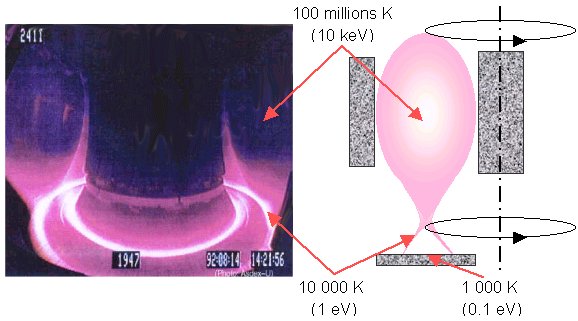|
5) Plasma-wall interaction and particles and heat
extraction (p 1 - 2
- 3 - 4
-
5 - 6 -
7 )
| As a result of
diffusion out toward the plasma edge, the particles end up by leaving the magnetic trap: what happens when they encounter the wall ? What does
the tokamak plasma edge look like? |
a)
Introduction
Despite the magnetic trap of the tokamak configuration, confinement of particles and energy in the plasma is not perfect, and heat and matter
diffuse from the centre towards the outwards. This has the result of taking large quantities of energy and particles towards the
plasma edge (with heat flows higher than those of the sun !). It is then up to the plasma facing components to simultaneously deal with both problems....
What does the
magnetic configuration in the edge look like
 ? The difference with the central plasma, where the field lines are in a closed circuit, is that in this zone , the field lines are open, interrupted by a solid obstacle (the plasma facing component). The border magnetic surface between the two zones is called Last Closed Magnetic Surface (LCMF).
? The difference with the central plasma, where the field lines are in a closed circuit, is that in this zone , the field lines are open, interrupted by a solid obstacle (the plasma facing component). The border magnetic surface between the two zones is called Last Closed Magnetic Surface (LCMF).  This LCMF is defined by the first point of contact with a solid object, which thus limits the plasma, hence the name of limiter for components which are in the frontline facing the plasma.
This LCMF is defined by the first point of contact with a solid object, which thus limits the plasma, hence the name of limiter for components which are in the frontline facing the plasma.
|
The charged particles, whether they are in the central or edge zone, always follow the field lines and will therefore enter into collision with the solid body: this is what we call plasma-wall interactions. On collision, the charged particles
neutralize (i.e. become atoms or molecules again by recovering electrons) and
do not feef any more the magnetic field, and are therefore free to move in the course of collisions with plasma facing components or other particles, until they ionise once again in contact with the plasma. They
then again start to follow the field lines, and may either supply the plasma with particles again if they have been ionised in the central zone of the
discharge, or once again collide with a solid body if they have been ionised
in the edge zone. This goes on until the particle has been taken out of the system, by being absorbed either by
an wall, or by the external pumping system. We call all these phenomena recycling.
|

|
We thus witness an extraordinary encounter, where the fourth state of matter (plasma) meets the 3 others (solid wall, the gas resulting from the interaction of the plasma with the wall, and liquid, flowing
a few centimetres below the surface of the wall to cool it down). We also go through a whole range of temperature, from
hundred millions of degrees for the central plasma to 10,000 degrees for the edge plasma where the molecules and atoms are, and 1000 degrees for the surface temperature of plasma facing components.
We can see these three temperature zones on a picture of the tokamak Asdex
 taken by a visible
taken by a visible
 light camera , where we see the edge plasma radiating strongly, while the central plasma, at a very high temperature, emits in a different range of wavelength (towards
the X rays
light camera , where we see the edge plasma radiating strongly, while the central plasma, at a very high temperature, emits in a different range of wavelength (towards
the X rays
 ) and appears to be transparent to the camera. ) and appears to be transparent to the camera.

|
|